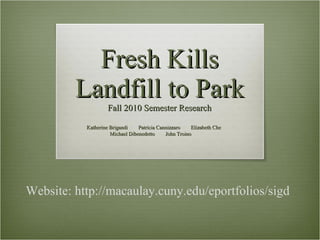
Freshkills research
- 1. Fresh Kills Landfill to Park Fall 2010 Semester Research Katherine Brigandi Patricia Cannizzaro Elizabeth Che Michael Dibenedetto John Troino Website: http://macaulay.cuny.edu/eportfolios/sigd
- 6. Introduction The Fresh Kills Landfill was once the second largest landfill in the entire world. It was opened in 1947, originally as a temporary landfill, but remained in operation for 50 years. Like most landfills constructed in the 1940s, Fresh Kills was not designed with liners or any other form of lechate control. Other problems such as local water contamination, hazardous chemical release, and local opposition lead to the closing of the landfill on December 31, 2001. Today, Fresh Kills landfill is being turned into a park over the span of 30 years. Landfill caps and other gas collection and treatment systems are used to ensure proper containment of wastes and promote a safe environment.
- 18. Future Plans: The park will be three times the size of Central Park. Parts of the park will be completed before others but the entire park is expected to take approximately 30 years to complete. Fresh kills Park will have five main areas: the Confluence, North Park, South Park, East Park and West Park. Each of these areas will have unique characteristics. Some of the fun and adventurous activities offered in the park will include horseback riding, mountain biking, nature trails, kayaking, and large–scale public art. Fresh kills Park will also support richly diverse habitats for wildlife, birds and plant communities. Settings of immense recreation will allow for some of the best camping sites in all of New York.
- 20. List of Research Sources: http://macaulay.cuny.edu/eportfolios/sigd/references/
- 25. Goats to be used for invasive plant removal and “mowing”. Invasive Phragmites.